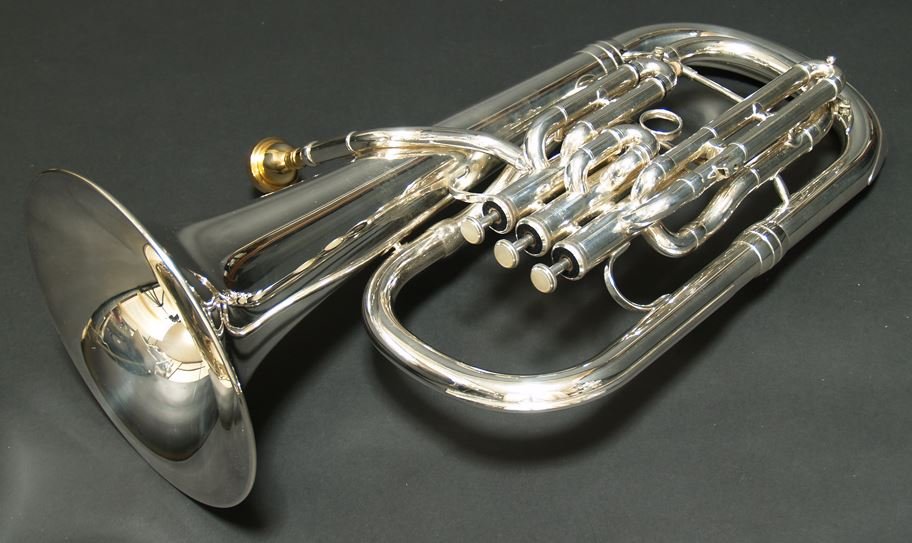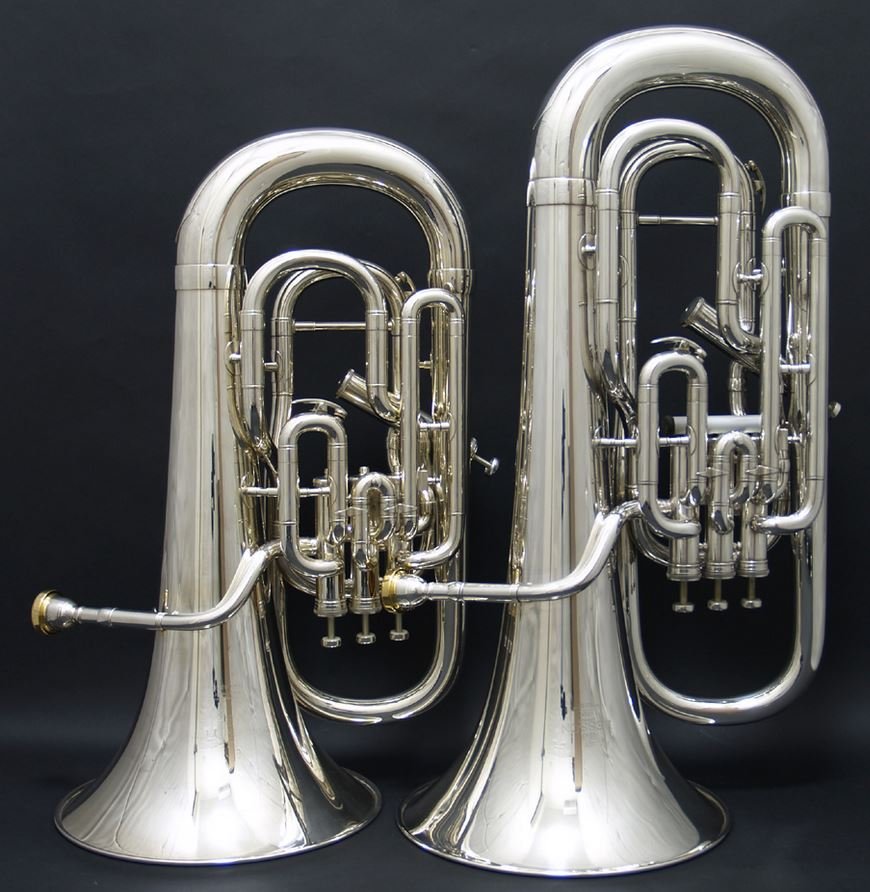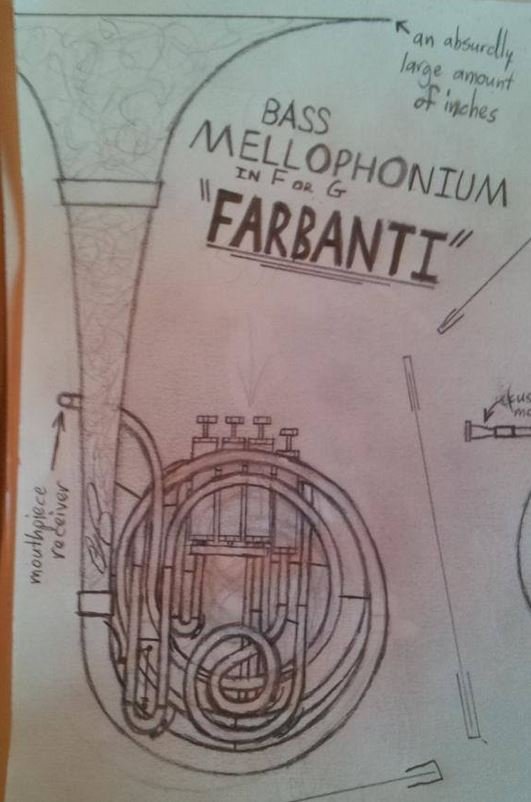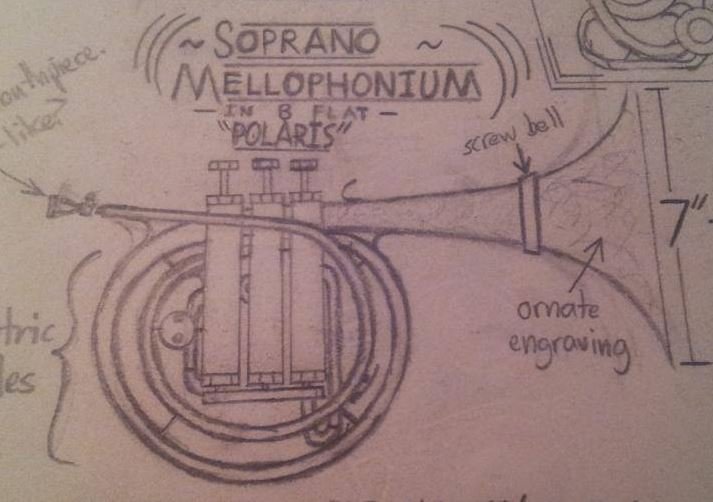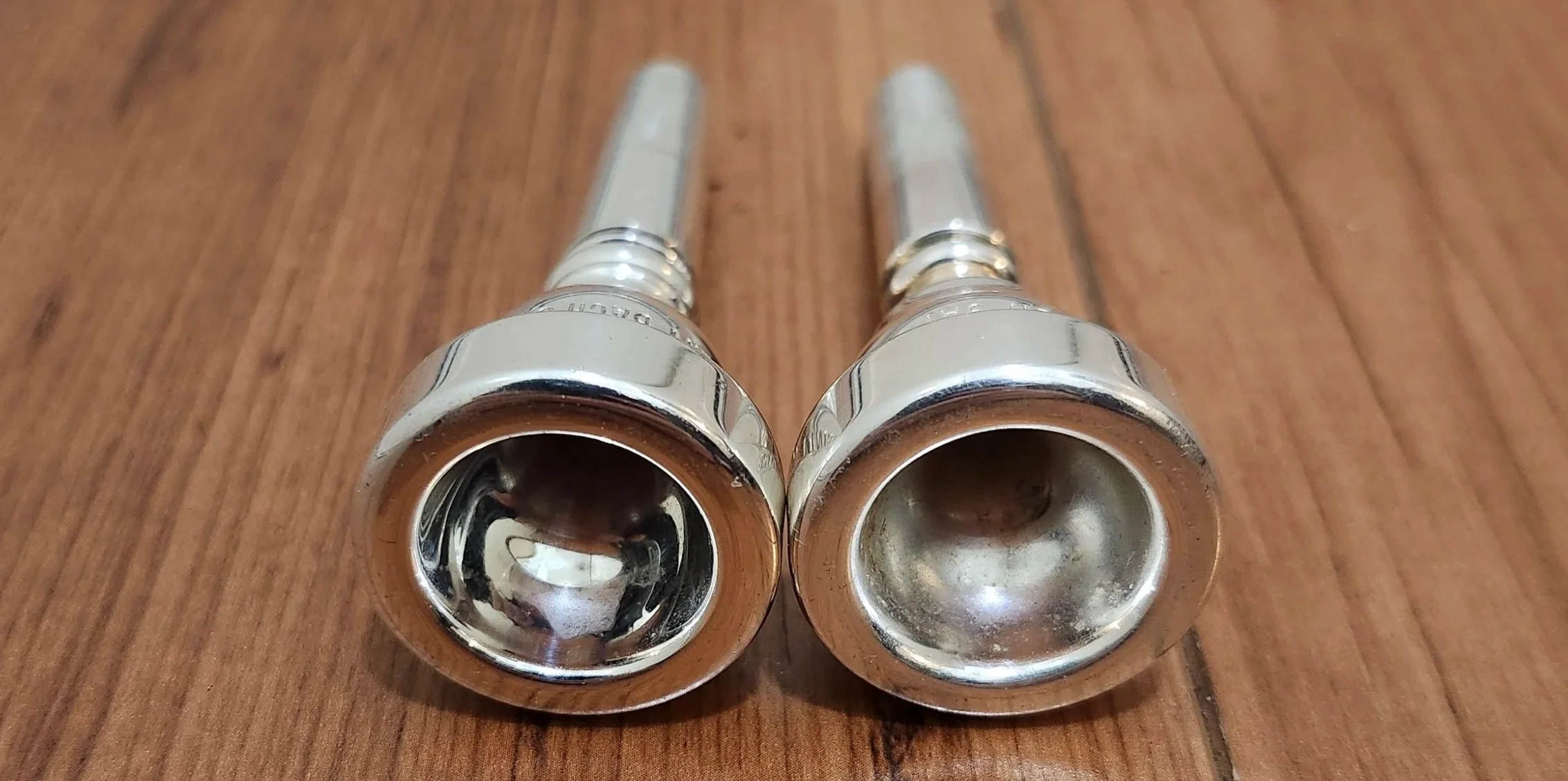Brass Instruments That Don't Exist (But Should)
It goes without saying (especially on this particular website) that there are a lot of brass instruments out there. Some probably shouldn’t exist, and others are probably not distinct enough to really deserve their own name. But they exist nonetheless, and going down the rabbit hole to discover and make sense of all of them is an endeavor that takes years.
But even though the concept of a mouthpiece attached to a metal cone has been tried hundreds or even thousands of ways, I believe we have not explored all that is possible in the brasswind medium. More to the point, I believe there are some brass instruments that should exist…but don’t. That’s what I’m going to discuss here, and hopefully inspire intrepid makers to make them a reality. (I can dream, ok?) Naturally, these are just my personal opinions, and if you have a different idea of a non-existent brass instrument that you wish was less non-existent, I’d love to hear about it.
Alto Euphonium
This might be the instrument I wish existed the most - a true F or E-flat alto tuba in the British euphonium style, with 3+1 compensating valves, a much larger bore and bell throat than an alto horn, and a small trombone mouthpiece shank. Technically, an alto euphonium does exist: the Yamaha YEH-901ST, which was made in a very limited (14 or 15) run in 1984-85 for Yamaha artists. It only had 3 valves, none of them have ever been for sale, and Yamaha no longer has the tooling to make any more. So although it technically does exist, practically speaking it might as well not. But this is the idea.
Yamaha YEH-901ST alto euphonium in E-flat (picture from Hidekazu Okayama’s website)
I plan to get an alto euphonium custom made for me from parts, as I really believe in its potential. Hopefully that project might inspire makers to give the concept a try. If my alto euphonium project is successful, I may then think about trying a soprano euphonium as well.
(Compensating) Euphonium in C
A similar (but less radical) instrument I’d like to see more of is a professional compensating euphonium in C. This did exist as the Besson BE765C, a special order instrument available until the company moved to Germany in 2006. That tooling is also likely long gone, and the picture below is the only evidence I have ever seen of the model. I can’t imagine more than a handful were ever made.
Besson BE765C-2 euphonium in C (left), Besson BE765-2 euphonium in B-flat (right). Picture from Hidekazu Okayama’s website.
C euphoniums do exist and are used in some parts of the world, but apart from the Besson above there are none that I know of that are British-style professional instruments. C tubas are a standard for orchestral tubists…I see no reason why a British-style compensating euphonium in C couldn’t also have merit, especially as a doubling instrument for tubists used to C fingerings.
6/4 American-Style Tenor Tuba
There have been some extra-large compensating euphoniums in the past, but what I’m proposing goes a step further. Massive 6/4 York-style C tubas are very much in vogue…why not try that same blueprint an octave up? Give it 4 front-action pistons with a 5th rotor and orchestral tuba players will flock to it as a doubling instrument even more than the C compensating euphonium mentioned above.
Bass Euphonium
I know what you’re thinking: “Isn’t a bass euphonium just an F tuba?” And I don’t blame you for thinking that, especially when small bell British F and Eb tubas that look and sound like big euphoniums exist. But my thought for an instrument called “bass euphonium” would be to take the dimensions of a modern compensating euphonium (.590” starting bore size) and use them to build an instrument in low G. The goal is an instrument somewhere in between a euphonium and bass tuba in sound. I will admit, this one isn’t that important to me, but I think it would be an interesting experiment. I have seen a few very small bass tubas for sale that have seemed like really good candidates to cut down into a bass euphonium. I’ve even seen a piston F tuba with a 12-inch bell!
Soprano Mellophone/Mellophonium
A custom Holton Bb soprano mellophonium, made from parts
A soprano mellophone in high B-flat is something I’ve wanted for a long time. A couple have been cobbled together from parts using trombone bells (see the above picture), but that’s not really the real deal. I’m talking new mandrels and tapers that match a modern mellophone, just a scaled down for an instrument a 4th higher. I would suggest still using a trumpet shank and the same bore size as an F mellophone, as you still want it to feel like a mellophone. Truthfully, I would love a soprano mellophonium with a .500” bore, the same as the Conn 16E mellophonium. But as no maker makes a bell-front mellophone that large anymore, you’d have to do that first and then make the high Bb version. Which…I would also welcome with open arms. I love my 16E, but that design leaves a ton of room for improvement by a modern maker.
Lower Mellophones
If the mellophone formula can be expanded upwards, why not downwards as well? I used to own a Conn 8E ballad horn from 1930, which is essentially a tenor mellophone in C or B-flat. But (to my knowledge) a modern bell-front tenor mellophone is not something that anyone has ever attempted. I even think a bass mellophone in F (an octave below the standard mellophone) would have a lot of potential.
I have been fascinated by the idea of a complete mellophone or mellophonium family for a long time, and even drew freehand sketches of what I would imagine some of the non-existent members could look like.
An old sketch of mine for a bass mellophonium in low F. I figured for an instrument of this length, an upright design was much more practical as a normal mellophonium is already an ergonomic challenge.
An old sketch of mine for a soprano mellophonium in high Bb.
I even sketched a little sopranino!
A Real Bass Horn
I’m not talking about the “bass horns” out there that are basically just rewrapped tubas. I’m talking about a proper double horn a 4th or 5th below a normal double horn, with a small bore proportionate to that of a normal horn, playable by a horn player or trombone/euphonium player, with a dedicated mouthpiece that’s a deep horn mouthpiece scaled up to around big alto horn (~19mm) or small trombone size. Much like modern descant horns usually use the same bells as double horns, the bass horn could use standard XL-throat double horn bells, like those from a Conn 8D or King Eroica.
Endangered Instruments
This category is for instruments that do exist, and you can even order them in some cases, but they are FAR too rare - often nearly impossible to find and/or prohibitively expensive. These are instruments that I would like to see someone step up and make more widely available. I think rare, odd instruments like these are the perfect specimens for Jinbao/Wessex/etc. to take on. They’ll be playable enough, but also affordable enough that many players can try them out, and maybe get a boutique maker to make them a better one if they like it enough. If you start with the ultra-expensive handmade custom horns, nobody will ever buy one and the market won’t materialize. But if you start cheap, it just might. Certainly, these instruments would make more sense and have more merit than some of the odd instruments Jinbao has chosen to clone.
Soprano flugelhorn (they are always in Eb, but I would love one in F as well)
Flugelhorn in C (with pistons and a 3rd slide trigger, just like a normal flugelhorn)
Martin-style jazz flugelhorn (the Miles Davis horn)
Alto flugelhorn (G, F, or Eb, a la the Couesnon)
Alto cornet (G, F, or Eb, a la the DEG model 1220)
Alto trumpet (G, F, or Eb)
Bass cornet (C or Bb)
Double trumpets (Bb/low F, Bb/high Eb, C/high F)
High F and G trumpets, especially with 4 valves
4-valve C and Bb trumpets
3-valve Bach-style piston bass trumpet in C (with main tuning trigger)
Contrabass trumpet (F or Eb)
British-style alto horn with 4 valves (most recent example: Kanstul ZAT-1540)
British-style 3+1 compensating baritone horn
Double bell alto horns, baritone horns, and tubas
British-style 3+2 non-compensating euphonium
Large bore (.500") soprano trombone (with valve and tuning-in-slide)
Large bore (.547”) alto trombone (with Bb valve, possibly tuning-in-slide)
Alto trombone in F
Alto valve trombone (F or Eb)
Large bore, bell-up trombonium (a la Conn 90G)
Bass trombonium (3 valves, in low F or Eb)
Sopranino trombone (F or Eb)
Tenor trombone in C
Tenor or bass trombone in Bb/F/ascending C
Double valve (Bb/F/Gb) tenor trombone (in .508”, .525”, and .547”)
Modern bass trombones in low G or F (hey pBone, please make a straight F bass. I’d love you forever)
G contrabass trombone (a la Jeff Reynolds)
Tuba-shaped F cimbasso (a la Kalison)
Tubas in G and D (G = shortened small F, D = shortened 4/4 rotary C)
Valved ophicleide (I would LOVE to try an F bass valved ophicleide in a brass quintet)
French ascending piston double horn (a la Selmer Thevet Ascendant)
Ascending double horns in general
Bass Vienna horn (F/C)
Other Pie-in-the-Sky Ideas (that I’m not actively hoping for, but would be fun)
Alto superbone
A superbone with 2 valves and a 4-position handslide, requiring you to use both in tandem constantly to play chromatically
New sizes of corno da tirarsi (slide horn), and corni da tirarsi with a valve or two
New sizes of Wagner tuba (alto in Eb, contrabass in C, high double in Eb/Bb, low double in F/C)
French ascending piston triple horn and double descant horn
Soprano trombones in G and C
Soprano valve trombone (in a shape and taper that distinguishes it from a trumpet)
3 and 4 valve trumpets (not alto trumpets, or soprano bugles) in G
Contrabass cornet in F or G
4-valve compensating flugelhorn
Tubas/euphs/baritones/tenor horns/cimbassos with echo bells (like an echo cornet)
A Bb contrabass trombone that doesn’t suck (the most unrealistic idea here)
Alto Trumpet (and other low-ish trumpets)
Without a doubt, the alto trumpet is the black sheep of the trumpet family.
Built in low F or E-flat, this instrument was allegedly invented by Nikolai Rimsky-Korsakov…at least, that’s what he claims in his treatise on orchestration. Regardless, he wrote for it often and his Russian contemporaries followed suit. But what is it really, and why is it essentially extinct?
The first and most important thing to note is that the alto trumpet is NOT the same instrument as the older orchestral trumpets in low F or E-flat, which are direct descendants of the long natural trumpets that came before and were written for by many popular orchestral composers (Mahler, Strauss, etc.). Those are true trumpets, rather than the mostly-cornet instruments we call “trumpets” today.
Although both the low orchestral trumpet and the alto trumpet are the same length and you might think the distinction is unnecessary, they are completely different instruments. I have experience with both types, and they could not be any more different in sound, feel, and function if they tried. The difference is as large as a modern tuba compared to an ophicleide.
As if two instruments in the same family that are the same length but are completely different was not confusing enough, there is actually a third instrument to throw into the mix: the F or E-flat bass trumpet.
These instruments have a larger bore and bell than alto trumpets and take a trombone mouthpiece, and function essentially the same as the more common C and B-flat bass trumpets. Once again, these instruments are entirely removed from either the low orchestral trumpet or alto trumpet in sound, feel, and function. E-flat bass trumpets are most often seen nowadays in German folk music, for example as the middle voice between a rotary flugelhorn and a large B-flat bass trumpet or bass flugelhorn. Here is a great example:
These three instruments are all trumpets in low F or E-flat, but they are completely different. To summarize:
F/Eb low orchestral trumpet: meant to be played in the same register as a Bb or C trumpet. It’s a natural trumpet with valves, and it plays and sounds as such. Uses a small mouthpiece.
F/Eb alto trumpet: meant to be played a 4th or 5th below the Bb trumpet. Designed from that instrument, rather than from the natural trumpet. Does what the name implies. Uses a mouthpiece in between trumpet and trombone in size (~19mm).
F/Eb bass trumpet: meant to be played roughly an octave below the Bb trumpet, like a C or Bb bass trumpet. Plays and sounds like any other bass trumpet. Uses a trombone mouthpiece.
While none of these instruments are particularly common, low orchestral trumpets are still made by Kuhnl & Hoyer and a few boutique makers (Thein, Egger, Dotzauer), and F/Eb bass trumpets still have a market (Thein, Meinl Weston, Helmut Voigt, Lars Gerdt, likely many more small German and Austrian makers).
This is not the case for the alto trumpet, which is currently made (to my knowledge) by nobody. Why is that?
The easiest explanation is the repertoire.
E-flat bass trumpet does have a few important parts in the orchestra such as the Rite of Spring, but the bass trumpet in C is the orchestral standard for all bass trumpet parts so you’re not likely to see an F or Eb bass trumpet in the orchestra. However, it has an established role in German folk music, and thus will always have a use and thus a market.
While the low orchestral trumpet is sadly totally extinct in the world of modern orchestral trumpeting, a massive portion of the standard orchestral canon was written for it, so there will always be a small interest in them for players that value authenticity or regularly engage in historically-informed orchestral performance.
The alto trumpet doesn’t have any existing use like that to rely on. There is some Russian repertoire for it, but all of those parts were deliberately written within the range of the Bb trumpet so that the part could still be covered if no alto trumpet was available. This is a logical move, but the unfortunate result is that there is zero incentive to get an alto trumpet for those parts. Mahler-style low orchestral trumpets suffer from the same issue; with a few notable exceptions, everything is well within the range of a Bb or C trumpet.
Scythian Suite (Prokofiev) - Movement 2, Trumpet 4 (F alto)
But suppose an intrepid player wanted to honor Rimsky-Korsakov’s intentions and get an F alto trumpet. The player might also point out that there is some research to indicate Wagner’s 3rd trumpet parts might have been intended for a similar instrument, in order to further justify their purchase. Where can they buy one?
Unfortunately, alto trumpet buying options are nearly nonexistent. As previously mentioned, nobody (to my knowledge) makes a new one. The closest thing is a trio of Carol Brass B-flat trumpet models that have alternate slides for G, and in two cases also F: the CTR-5000L-YLT-Bb/G-L, the Tri-KEY PRO, and the Saxy Trumpet Bb/G/F - L. To get one of these you’d also have to find a dealer that would be willing to get one for you, as I haven’t found any online store that stocks them.
You might find some luck with Italian brass makers, as Italian military and police bands are the only place I know of where the alto trumpet has seen regular use, with the 3rd trumpet part often played on F altos instead of Bbs. Those bands are anomalous in other ways too, though - cimbasso, bass trumpets, and Eb soprano flugelhorns are standard features of those bands (though the Eb flugelhorn isn’t so common anymore, usually being substituted by Eb cornet).
The 3 alto trumpeters of the Banda dell’Arma dei Carabinieri, from their 2016 performance at the Kennedy Center. This ensemble also had 2 bass trumpets and a plethora of other uncommon instruments.
As an aside, alto trumpet does have some further history with concert bands. In the spectacular 1923-1924 roster for the University of Illinois Concert Band, one alto trumpet player is listed:
Okay, so what about buying an alto trumpet used? Well, here is a summary of the used alto trumpet market, from my experience:
Bach “contralto” trumpets (made in either F or Eb): enormously rare, and when they do show up for sale they have the Collectible Bach Tax™ and are very expensive. Not that they were cheap when they were new, mind you. I am fortunate enough to own one of these with a gold brass bell (model 351G). The Bach catalogs I’ve seen universally designate this instrument the 187F (with the Eb version being noted as a special order variation), but the only model number on mine is the “351G” stamped on the bell. Technically speaking, both of these numbers are actually part names, for the mouthpipe (187) and bell mandrel (351). I haven’t found a catalog that calls the instrument a 351, but being as Bach C and Bb trumpets are often referred to by their bell mandrel number (37, 229, etc.), it seems reasonable to me that this instrument can also be referred to as a 351. These instruments have a .468” bore, 5¼” bell, and a slightly oversized trumpet shank. The Bach 9AT alto trumpet mouthpiece was designed for this instrument and supplied with it from the factory. I have owned two different 9ATs with two different blanks, and they are a good match for the horn.
Holton 56 (Eb only) and Olds Custom F-10: both ultra rare, and usually expensive.
Conn 34B, 40B, 50B (all Eb only): very rarely show up for sale. If you do manage to find one, beware: everything I have read about them says that they are very stuffy and generally bad to play.
Getzen 389 (F with Eb slide): By far the most common used alto trumpet to show up, but still not common at all. Plus, it’s a student-level instrument that by all accounts is not that great. Make sure to not mistake a Getzen frumpet for one, as they look similar.
Getzen 389 alto trumpet in F and E-flat (E-flat slide installed)
A page from a Getzen catalog showing the frumpet, alto trumpet, and bass trumpet
Amati Kraslice ATR-262 (E-flat): I’ve only seen these show up for sale a handful of times, and there’s no other information out there that I can find. But it appears to be an alto trumpet with a bell big flare.
Kühnl & Hoyer low Ebs (model 599/599K): I include these only to warn you that these are not actually alto trumpets. They look like they should be as they have piston valves and a very normal wrap (in either the short (599K) or long (599) variety), but they are actually long orchestral trumpets like the old rotaries in terrible condition that live on eBay.
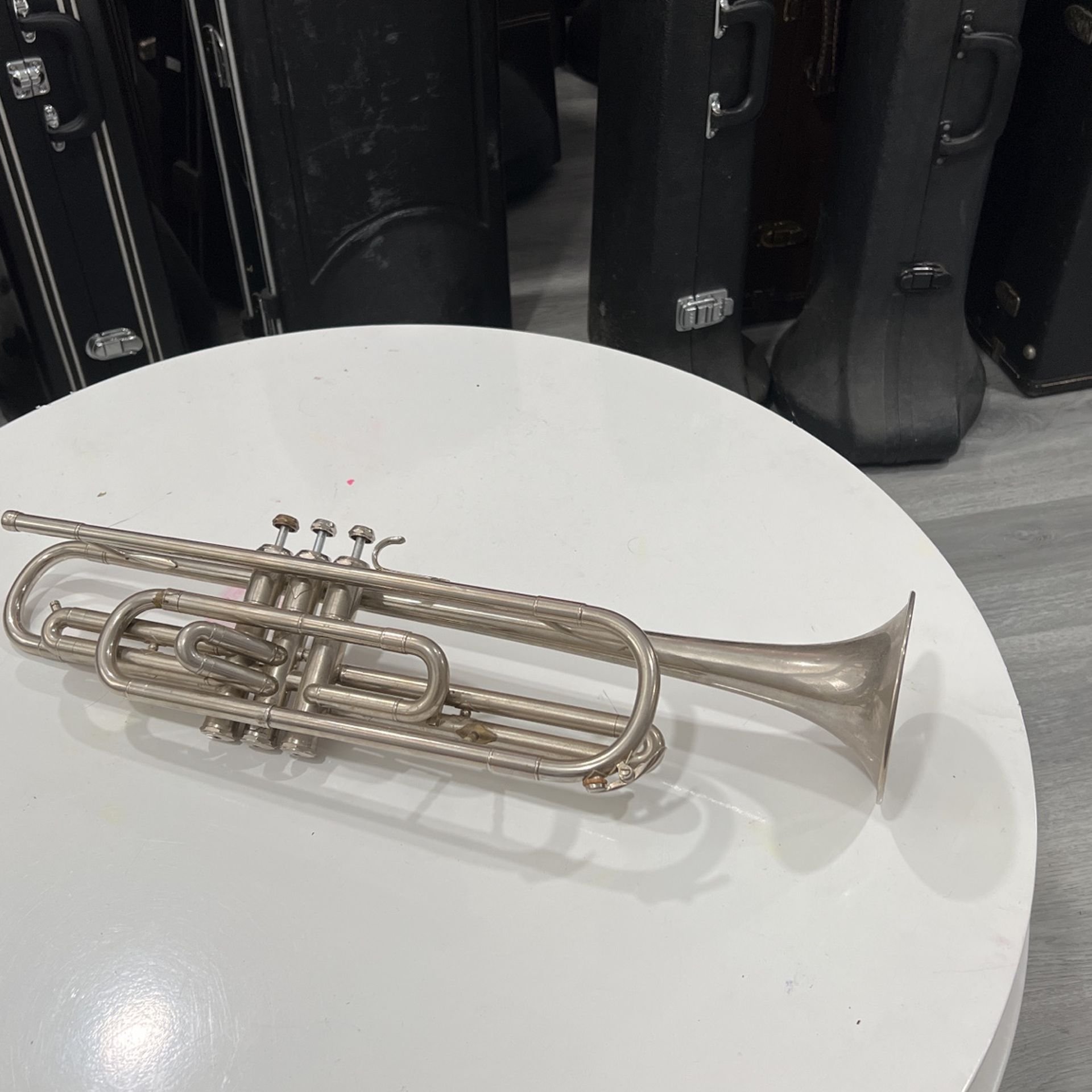
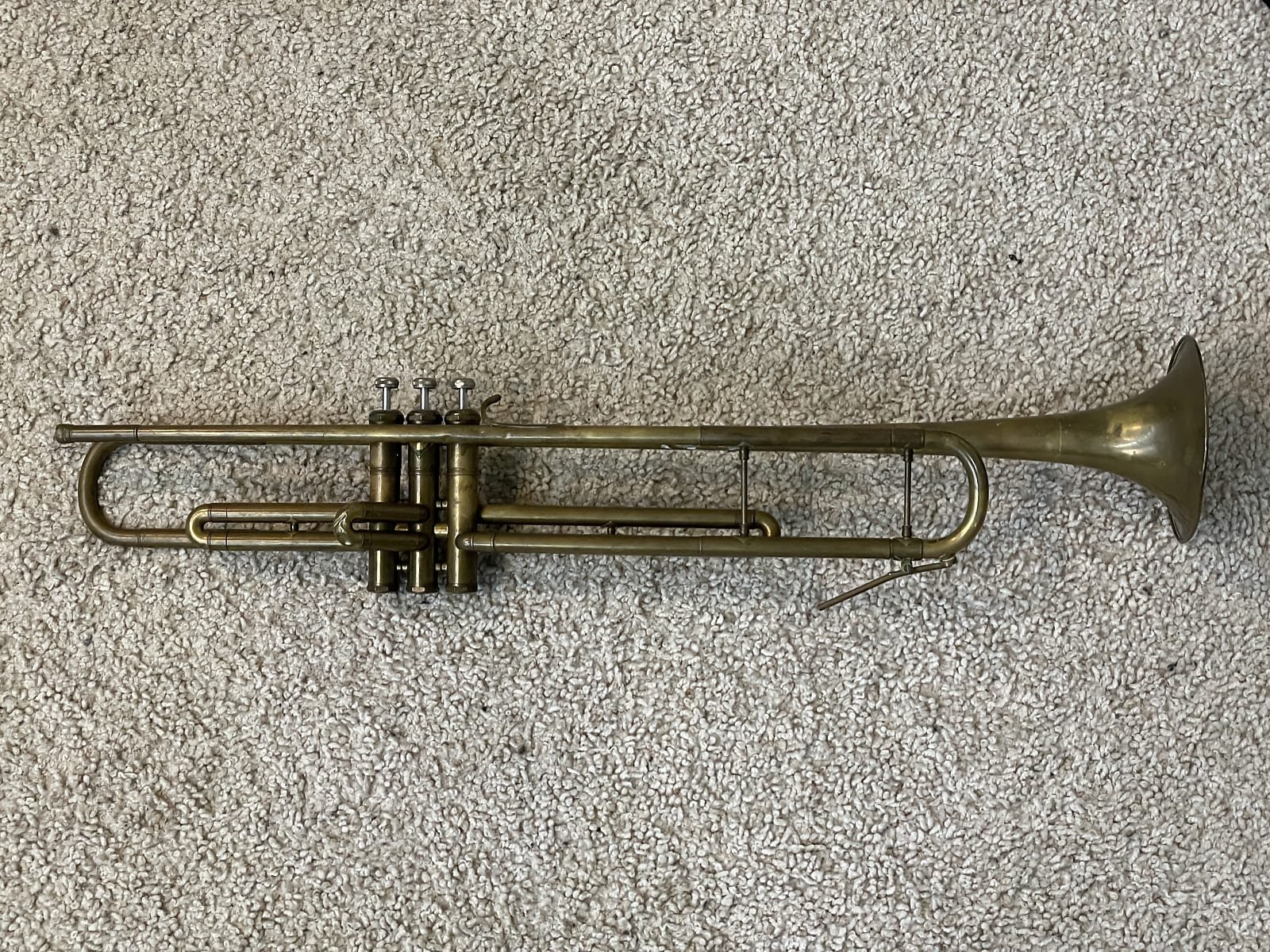

3-valve G soprano bugle: The old drum corps G soprano bugles were basically trumpets in low G with an extra-large bore and bell throat. This means that with a suitably large mouthpiece, they actually work very well as a G alto trumpet. As a bonus, the Dynasty 3-valve sopranos show up on eBay quite frequently at very affordable prices (usually $150-250). While these are not in F or Eb and you would thus have to transpose (or get slide extensions made), they can play down to concert Db3, which covers every extra low note in the repertoire except for the low C in Mozart 41 (which is not an important note anyway). Used Kanstul sopranos are less common and more expensive, but generally regarded as the better instrument. You could also buy a brand new Kanstul-pattern one from BAC if you really wanted to.
Dynasty 3-valve soprano bugle in G
My conclusion is simple: every orchestral trumpeter should own a 3-valve G soprano bugle. It costs nearly nothing, plays well, and covers all your extra-low needs. Use it on parts intended for alto trumpet (Rimsky-Korsakov 3rd trumpet parts) even if they don’t go below the range of a Bb. Use it for Carmen, use it for Heldenleben, use it for trumpets 4/5/6 in Mahler 6. Use it for all those old 2nd parts written for natural trumpet that throw in a random 2nd partial note or two (Don Giovanni and Manfred Overture for example).
A-flat Trumpets
A-flat seems like an odd key to build a trumpet in, and I’m not sure how many purpose-built trumpets in A-flat there have been. The few I’ve seen have been normal B-flat trumpets with longer main tuning crooks to put them in B-flat. These don’t really qualify for the alto trumpet discussion, but they do at least give you a whole step of lower range not available on a normal B-flat trumpet.
These A-flat trumpets were built for German Posaunenchor (“trombone choir”), which despite the name has come to refer to any mixed brass ensemble. As far as I’ve been able to find out, the idea of the Posaunenchor A-flat trumpets is to allow trumpet players used to reading C trumpet music on a B-flat trumpet to use the same fingerings on B-flat trumpet music. I have only seen a few turn up for sale on German eBay, but they are out there. I would love to learn more about these instruments, their history in Posaunenchor, and the history of Posaunenchor in general.
A Blessing Scholastic B-flat trumpet converted to A-flat for Posaunenchor use
